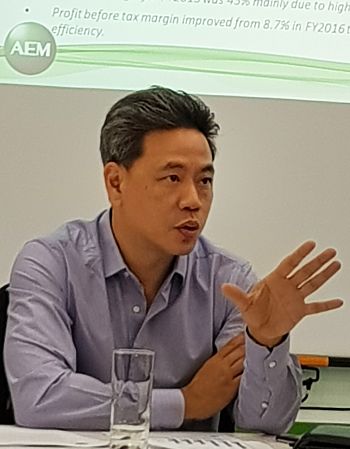|
AEM Holdings, whose stock price has risen 389% in the year to date, continues to rock.
Assuming a 17.2% corporate tax rate (as used by CIMB in its analysis of AEM's 1H2017 results): ♦ 2017 profit after tax would come up to at least S$26.5 million, or an EPS of at least 40 cents. ♦ The PE of AEM's stock, based on 2017 earnings, would then be not higher than 7X (using this morning's traded price of $2.80). ♦ Dividends for 2017 would total not less than 10 cents a share, as AEM's policy (implemented this year) is to pay not less than 25% of net profit after tax as dividends. FY2017 interim dividend was 2.5 cents a share, so what's coming after the 3Q and 4Q results would be no less than 7.5 cents a share of dividends. |
||||||||||||
AEM made its 7 Aug 2017 guidance when it released its 2Q results -- but this morning's announcement is a standalone made ahead of its 3Q17 results release which probably is a few weeks away (3Q16 results release: 8 Nov 2016).
Investors may interpret that to mean AEM had considered that its internal profit estimate had turned out to be so significantly higher than its August guidance that the new estimate could not -- to be fair to the market -- wait until the 3Q results release.
 Loke Wai San, 49. ♦ Non-executive Chairman of AEM since 2011, appointed Executive Chairman on 1 Oct 2017. ♦ Concurrently, Managing Director of Novo Tellus Capital Partners and had led Novo Tellus PE Fund I’s investment in AEM. (NextInsight file photo)
|
||||||||||||
AEM said the higher estimate is mainly attributed to "higher sales, better profit margin, and better operational efficiency as a result of strong customer demand coupled with benefits from the Company’s ongoing efforts at upgrading operational productivity."
Few, if any other, Singapore listcos give such profit guidance but AEM can because its profitability is almost wholly derived from one customer and AEM gets sales orders for fulfillment a few months down the road.
That customer is the largest semiconductor company in the world, whose identity AEM doesn't talk about but it's an open secret that it is Intel Corp.
Being dependent on one customer is AEM's key business risk.
But AEM has asserted that its equipement, which was co-developed with the customer over a few years, is revolutionary and saves significant costs for its customer, so it is set to replace competing suppliers'.
AEM is now in the first year of a multi-year ramp-up in its customer's replacement cycle for that test-handling equipment which is used in testing semiconductor chips.
In addition to the equipment, AEM produces related consumables which generate recurring and higher-margin income over the lifespan of the equipment.







